Yesterday, President Obama gave a speech commemorating the 50th anniversary of the march from Selma, Alabama. There's been a lot of reaction to it, most of it positive. There was also that movie about Selma, released recently, but which I have not seen. I somehow manage never to get to the movie theatre these days.
I am embarrassed to admit this, but in listening to Obama's speech and in reading journalists' comments on it, I don't know what "Bloody Sunday" refers to. I hear that and I think of the Troubles in Ireland (such a nice, delicate way of describing centuries' worth of Catholic vs. Protestant bombings and murders).
But of course I know that these speeches about Selma, Alabama, can't be talking about Ireland, that they mean events that took place during the civil rights protests in 1965. But that's about all I know.
So what did happen in Selma, Alabama in 1965? And to give me a place to start, why Selma?

Now that I've read the whole story, I see how this Life magazine cover photo pretty much says it all. The two guys in front of the two-by-two column of people are Hosea Williams (L) and John Lewis (R).
(Life cover image from Successimg.com)

Jim Clark, Sheriff of Selma, Alabama in 1965, violently opposed to black voting rights.
(UPI photo from NYT)

Martin Luther King, Jr. You know who he was, of course.
(Photo from funcheapsf)

Jimmy Lee Jackson, deacon, 26, shot for trying to keep his mother from getting beaten up.
(Photo sourced from the Northeastern University School of Law)

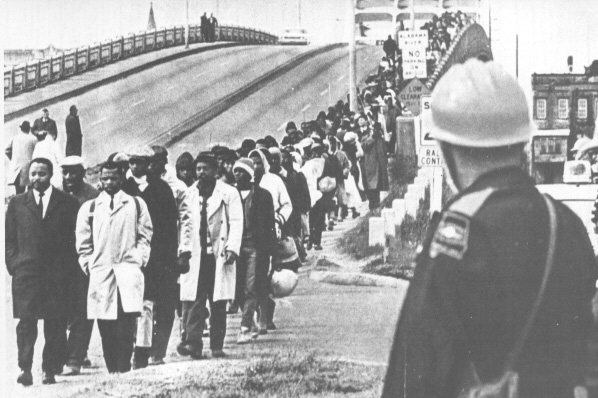
This is what the first march looked like, coming over the bridge from Selma, led by John Lewis and Hosea Williams.
(Photo sourced from crmvet.org)

What was waiting for the marchers
(Photo sourced from crmvet.org)
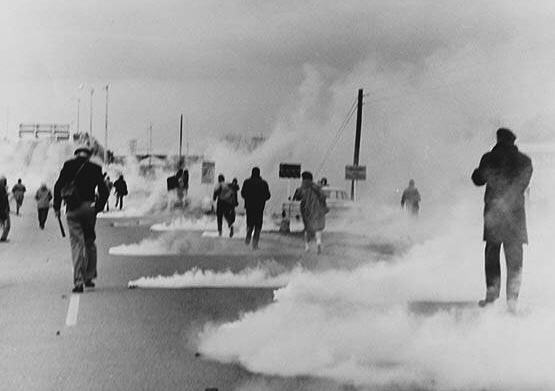
Tear gas canisters all up the road in Selma
(Photo sourced from crmvet.org)
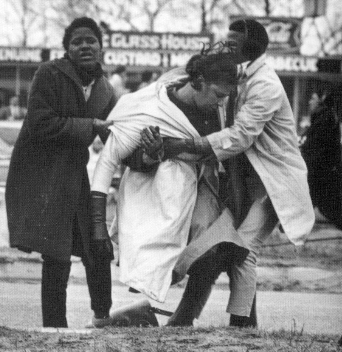
Some of the wounded
(Photo sourced from crmvet.org)

John Lewis, one of the leaders of the first march, shown here in the foreground in the light overcoat.
(Photo from Raceandpoverty.org)

This is an excerpt from some historical documentary, beginning with a description of what was happening in Selma leading up to Bloody Sunday. The guy pointing his billy club at the camera is Sheriff Jim Clark. Toward the end is footage from Bloody Sunday itself.

What the third march looked like, coming into Montgomery
(Photo sourced from Jacobin Magazine)

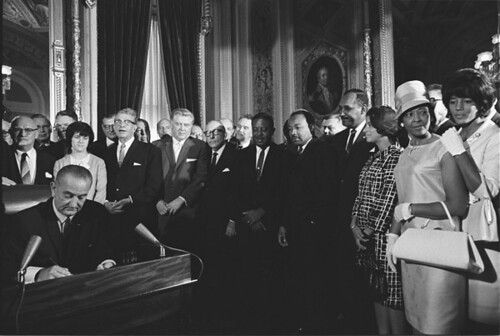
President Johnson signing the Voting Rights Act into law
(Photo from the National Archives on Flickr)
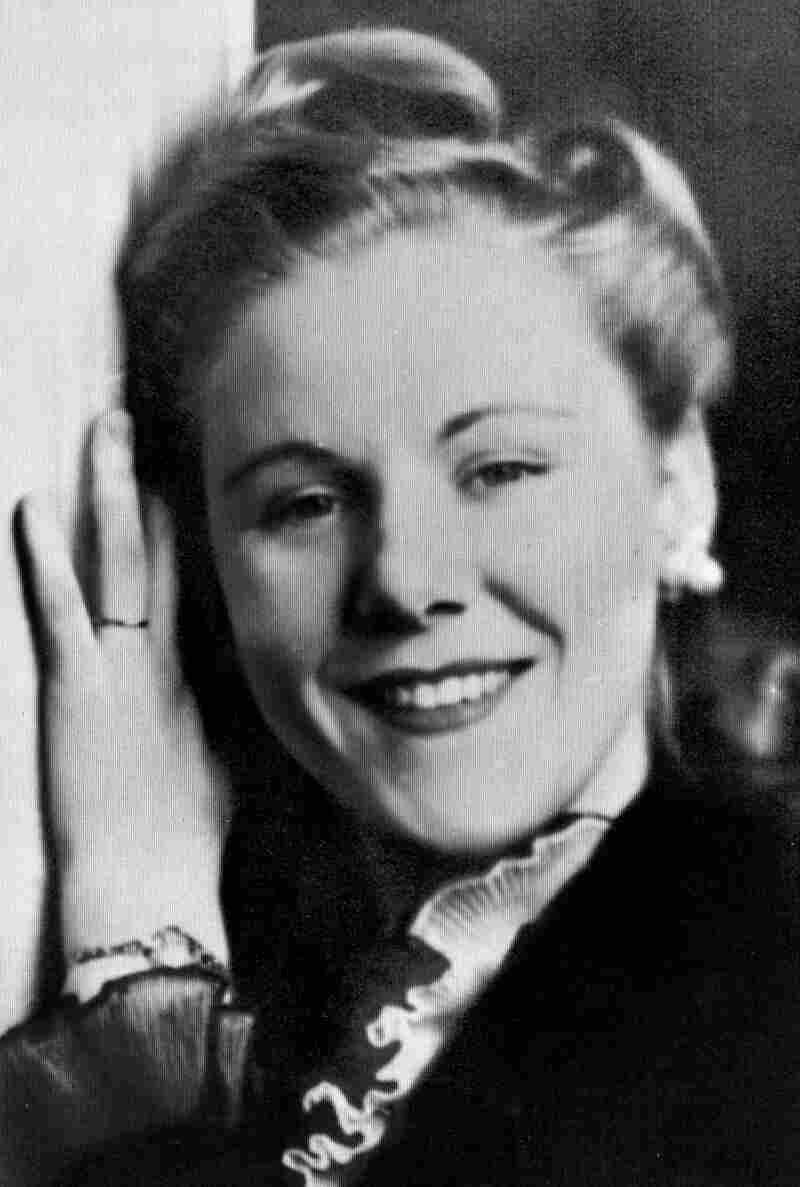
Viola Liuzzo, one of the marchers from Selma to Montgomery, originally from Detroit, killed for giving a black teen-ager a ride home.
(AP photo from NPR)
I would show you a photo of Leroy Moton from that time, but money-grubbing Corbis owns them all. So if you want to see what Leroy looked like, here's a photo of him.
P.S.

Today, John Lewis is a member of the House of Representatives, and currently serves as Senior Chief Deputy Whip for the Democratic Party. Know how he got there? Votes.
(Photo from John Lewis's Congressional page)
Sources
Stanford University, Martin Luther King Institute, Selma to Montgomery March (1965)
History Channel, Civil Rights Movement Video, Bloody Sunday (5 min)
The National Archives, Confrontations for Justice, John Lewis - March from Selma to Montgomery, "Bloody Sunday," 1965
BlackPast.org, Selma, Alabama (Bloody Sunday, March 7, 1965)
AL.com, KKK fliers left at Selma homes on 50th anniversary of "Bloody Sunday," March 8, 2015
Sheriff Jim Clark
The New York Times, Jim Clark, Sheriff Who Enforced Segregation, Dies at 84, June 7, 2007
Jimmy Lee Jackson
Northeastern University School of Law, Jimmie Lee Jackson
James Reeb
Stanford University, Martin Luther King Institute, Reeb, James (1927-1965)
James Reeb Unitarian Universalist Congregation, Who Was James Reeb?
Viola Liuzzo
Biography, Viola Gregg Liuzzo
NPR, Killed for Taking Part in "Everybody's Fight," August 12, 2013
I am embarrassed to admit this, but in listening to Obama's speech and in reading journalists' comments on it, I don't know what "Bloody Sunday" refers to. I hear that and I think of the Troubles in Ireland (such a nice, delicate way of describing centuries' worth of Catholic vs. Protestant bombings and murders).
But of course I know that these speeches about Selma, Alabama, can't be talking about Ireland, that they mean events that took place during the civil rights protests in 1965. But that's about all I know.
So what did happen in Selma, Alabama in 1965? And to give me a place to start, why Selma?

Now that I've read the whole story, I see how this Life magazine cover photo pretty much says it all. The two guys in front of the two-by-two column of people are Hosea Williams (L) and John Lewis (R).
(Life cover image from Successimg.com)
- The Civil Rights Act was passed in 1964. That was supposed to stop people and communities from discriminating against other people on the basis of race or color or sex or religion or national origin. One of the ways people weren't supposed to be discriminated against was in matters related to voting. But in fact, even though the nation-wide law of the land forbade it, many communities were still preventing people -- mainly African Americans -- from voting.
- One of the places where this was happening most egregiously was in Selma, Alabama. Some sources say only 2 percent of Selma's eligible black voters were registered to vote; other sources say less than 1 percent.
- Selma was the county seat of Dallas County and the county sheriff, Jim Clark, had been very vocal in his opposition to blacks being allowed to vote. He went around wearing a button that said "Never," meaning never allow black people to vote. At one voting rights demonstration, he rounded up all the protestors using cattle prods and forced them to march faster and faster until a number of the protestors vomited.

Jim Clark, Sheriff of Selma, Alabama in 1965, violently opposed to black voting rights.
(UPI photo from NYT)
- He was friends with people in the KKK, and he organized a posse -- literally, a posse -- of KKK members alongside police officers to stand around in front of places where black people were going to register to vote. His posse guys were also armed with billy clubs and cattle prods.
- African Americans who had shown up to these registration drives either to register or to demonstrate and encourage others to vote were harassed, shouted at, threatened, or beaten.
- There were two locally-organized groups that were trying to prevail in spite of this neanderthal. These two groups were called the Student Nonviolent Coordinating Committee (SNCC) and the Southern Christian Leadership Conference (SCLC).
- It was around this time that Dr. Martin Luther King was informed of what was happening in Selma. He supported both groups' efforts and encouraged them to continue to conduct nonviolent protests against the practices of Jim Clark et al., to draw national attention to the problem, and to raise national awareness about the fact that people were still being kept from voting.

Martin Luther King, Jr. You know who he was, of course.
(Photo from funcheapsf)
- Many of the demonstrations that the groups held, which took place in January and February of 1965, were conducted outside the Dallas County Courthouse. They were trying to bring the problem literally to the steps of the courthouse, which was supposed to uphold the Civil Rights Act, but was not.
- During one of these demonstrations, on February 17, sheriff Clark and his men, who were also joined by state troopers sent to Selma by Governor Wallace, decided to break up the march by beating the men and women who had assembled with their billy clubs. This was nothing new, really. They had responded to other demonstrations in similarly violent ways.
- On this particular evening, some of the demonstrators tried to get away from the troopers with clubs by running into a cafe. But the troopers followed them in and started whaling on an older man, someone's grandfather. His daughter rushed to the man's aid, and the trooper knocked her down. Then her son, Jimmy Lee Jackson, stepped in and tried to protect his mother from being hit some more. The state trooper responded by pulling out his gun and shooting Jackson, point-blank, in the abdomen.
- Jackson, a 26 year-old church deacon, died of his wounds eight days later.

Jimmy Lee Jackson, deacon, 26, shot for trying to keep his mother from getting beaten up.
(Photo sourced from the Northeastern University School of Law)
- One of the organizers of the SCLC, Reverend James Bevell, said they should take the body of Jimmy Lee Jackson in a funeral cortege all the way to the state capitol, Montgomery, to show the state of Alabama and the country at large what had happened. In discussing this idea and planning how to make it happen, they decided it should be a march from Selma to Montgomery.
The First Attempt -- Bloody Sunday

Map showing the road -- Highway 80 -- from Selma, AL to the state capital, Montgomery.
(Map from the National Park Service)

This is what the first march looked like, coming over the bridge from Selma, led by John Lewis and Hosea Williams.
(Photo sourced from crmvet.org)
- On March 7, led by the SNCC and the SCLC, some 600 people gathered at a church in downtown Selma, knelt together in prayer, and then began their march walking two-by-two through Selma, intending to go all the way to Montgomery, which is about 50 miles away.
- The road from Selma to Montgomery goes south out of Selma before it cuts east. The southern edge of Selma is bounded by the Alabama River. The bridge going over the river is the Edmund Pettus Bridge. So essentially, once you cross the Edmund Pettus Bridge over the Alabama River, you're outside Selma, with about 49 1/2 miles to go to Montgomery.
- The 600 marchers made it as far as this bridge when they were confronted by a blockade of sheriff Clark's men and his stupid posse and state troopers sent there by Governor Wallace. I cannot believe, in 1965, there was a freakin' posse. But there was.
- The troopers and policemen and the KKK whatnots were armed with billy clubs and bullwhips, and they were wearing gas masks. In other words, they showed up ready for a fight.

What was waiting for the marchers
(Photo sourced from crmvet.org)
- A state trooper named Major Cloud got on his bullhorn and told the marchers that this was the end of their demonstration, that it was unlawful, and they had two minutes to disperse.
- Well, it wasn't unlawful at all. So the marchers did not disperse. They didn't do anything else, either. They didn't rush forward or do anything threatening. They just continued to stand there.
- But this apparently was unacceptable to Major Cloud because he gave the order to the troopers to advance, and they did. They pushed their mass of people into the two-by-two line of marchers and pushed them down like a steamshovel knocking down bowling pins. And then they started hitting people.
- They beat people -- men and women -- with their billy clubs. They released their tear gas and clouds of it were everywhere. It was pretty much a nightmare.

Tear gas canisters all up the road in Selma
(Photo sourced from crmvet.org)

Some of the wounded
(Photo sourced from crmvet.org)
- Multiple people were beaten, in the head, in the face, on the back. They walked away with bloodied faces and broken noses. One of the fifty-eight people beaten severely enough they had to be treated at a local hospital was John Lewis, chairman of the SNCC. His skull was fractured.
- Here is an excerpt from his testimony given in a federal hearing following this march. The guy questioning him is an attorney.
Lewis: I was hit on my head right here.
Hall: What were you hit with?
Lewis: I was hit with a billy club, and I saw the State Trooper that hit me.
Hall: How many times were you hit?
Lewis: I was hit twice, once when I was lying down and was attempting to get up.
Hall: Do we understand you to say were hit . . . and then attempted to get up and were hit—and was hit again.
Lewis: Right.

John Lewis, one of the leaders of the first march, shown here in the foreground in the light overcoat.
(Photo from Raceandpoverty.org)

John Lewis being hit by a state trooper in Selma, AL, 1965.
(AP file photo sourced from the Tampa Tribune)

Hosea Williams, the guy who co-led the first march with John Lewis. The photo was taken probably ten years or so later, when Williams held various political positions in Georgia.
(Photo from the New Georgia Encyclopedia)

Hosea Williams, the guy who co-led the first march with John Lewis. The photo was taken probably ten years or so later, when Williams held various political positions in Georgia.
(Photo from the New Georgia Encyclopedia)
- At the conclusion of the hearing, Judge Frank Johnson, Jr., ruled that the demonstrators had a constitutional right to march. Which means the troopers and Clark and all the rest of those hooligans in uniform had no right to do what they did.
- All this might have passed by the notice of most people in the country, making it only in a few newspapers, except that cameramen from TV news stations were there and filmed the whole thing. So it was broadcast on TV news around the country. And people across the country who saw this footage were horrified.
- I found some of this footage so you could see it for yourself.
This is an excerpt from some historical documentary, beginning with a description of what was happening in Selma leading up to Bloody Sunday. The guy pointing his billy club at the camera is Sheriff Jim Clark. Toward the end is footage from Bloody Sunday itself.
The first 3 minutes of this video show, without commentary, some of the footage from Blood Sunday.
- Dr. King was sending out telegrams and press releases and public statements, decrying the response of law enforcement, and calling on religious leaders across the country to join their cause. They would try their march again, he said, and the more people who would join their nonviolent demonstration, the better.
- That same judge who said their first march was lawful told Dr. King he was going to issue a restraining order to prevent the march from going forward, at least for a few more days, until March 11. He wanted enough time for a federal court order to go through so that a different batch of lawmen could be dispatched to Selma to provide protection for the marchers against Clark et al.
- Dr. King sort of did and sort of did not do what the judge said.
The Second March -- March 9
- Two days after Bloody Sunday, somewhat against the orders of the judge, Dr. King led 2,000 plus people -- note that the number more than tripled in two days -- as far as the Edmund Pettus Bridge. There, they stopped and knelt to pray. Then they turned and went back to Selma.
- The troopers were still there, at the far side of the bridge. By not crossing the bridge, the marchers did not antagonize the troopers. But they also did not back down from their own decision to make some sort of demonstration. And it was peaceful.
- At some point on this day, King gave a speech which included the statement, "I would rather die on the highways of Alabama, than make a butchery of my conscience." Strong stuff, Dr. King.
- By this time, President Lyndon Johnson was very well aware of everything that was going on. He promised, in the wake of the second march, to introduce legislation that would specifically guarantee voting rights, and that he would do so within a matter of days.
- A white Unitarian minister named James Reeb was one of hundreds of people who had seen the coverage of Bloody Sunday on TV and who flew to Selma to participate in the demonstrations. The night of March 9, he and two other Unitarian ministers were eating in a restaurant in Selma that served both whites and blacks. After they left that restaurant, they were walking back to a meeting that would be led by Dr. King when they were attacked by "local whites."
- Reeb was beaten severely in the head with a club. Somehow, it was several hours before he was brought to a hospital in Birmingham, where doctors performed brain surgery. But to no avail. The Unitarian minister, born in Kansas and ministering in Boston, died two days later. He was 38 years old.
- Reeb's death galvanized many more people in the country. If those "local whites" in Selma would kill a white man over this race thing, clearly they were way out of line.
- (You still see this sort of thing in movies all the time. The black sidekick gets killed, because he's expendable, and this is what spurs the white hero into action. Or a bunch of black guys in the background get shot, but it's only when one of the white guys who actually has a speaking part gets wounded that the white hero really gets ticked off and starts kicking ass and taking names. We've still got a long way to go.)
- All sorts of things started happening. Johnson addressed Congress, saying, "Their cause must be our cause too. Because it is not just Negroes, but really it is all of us, who must overcome the crippling legacy of bigotry and injustice. And we shall overcome." More importantly, he submitted his voting rights legislation to Congress on March 17.
- The Selma demonstrators submitted a detailed plan, describing their plans to march from Selma to Montgomery, to that judge, Frank Johnson, Jr., and he approved it. He then called up Governor Wallace and asked him to call off his dogs -- er, troopers. But to be on the safe side, the federal government also sent hundreds of Alabama National Guardsman to protect the marchers.
The Third Time's the Charm
- The third march set out on March 21. This time, there were 3,200 people. Some sources say there were 8,000, but the judge said they had to limit the number to 300 people at a time marching along the two-lane highway. This time, they were protected by National Guardsmen and members of the FBI.
- They walked from Selma to Montgomery, covering anywhere from 7 to 17 miles per day. They camped out at night on land belonging to people sympathetic to the demonstration. By the time they got to Montgomery, the number of marchers had greatly expanded to some 25,000 people.

What the third march looked like, coming into Montgomery
(Photo sourced from Jacobin Magazine)
- They reached he capitol building four days later, on March 25. Dr. King delivered a speech on the steps of the capitol building. It was here that he said the following:
"I know you are asking today, "How long will it take?" (Speak, sir) Somebody's asking, "How long will prejudice blind the visions of men, darken their understanding, and drive bright-eyed wisdom from her sacred throne?" Somebody's asking, "When will wounded justice, lying prostrate on the streets of Selma and Birmingham and communities all over the South, be lifted from this dust of shame to reign supreme among the children of men?" Somebody's asking, "When will the radiant star of hope be plunged against the nocturnal bosom of this lonely night, (Speak, speak, speak) plucked from weary souls with chains of fear and the manacles of death? How long will justice be crucified, (Speak) and truth bear it?" (Yes, sir) I come to say to you this afternoon, however difficult the moment, (Yes, sir) however frustrating the hour, it will not be long, (No sir) because "truth crushed to earth will rise again." (Yes, sir) How long? Not long, (Yes, sir) because "no lie can live forever." (Yes, sir) How long? Not long, (All right. How long) because "you shall reap what you sow." (Yes, sir)"
"How long? Not long, because the arc of the moral universe is long, but it bends toward justice."

Aerial photo of the demonstrators gathered in front of the capitol building in Montgomery.
(Library of Congress photo sourced from On This Very Spot)
- After this speech, a delegation from the marchers tried to deliver a petition to Governor Wallace. The doors of the capitol were blocked by -- who else? -- a line of state troopers. The delegation asked that the petition be delivered to the governor. They were told that the governor was not in. They remained on the steps with the petition until one of the governor's secretaries came out and collected the petition.
- Five months later, on August 6, President Johnson signed into law the Voting Rights Act of 1965. As he signed this bill into law, he called the right to vote "the most powerful instrument ever devised by man for breaking down injustice and destroying the terrible walls which imprison men because they are different from other men." (and women too, I would add)

President Johnson signing the Voting Rights Act into law
(Photo from the National Archives on Flickr)
But It's Still Not Over
- Although the march was ultimately successful in helping to secure a voting rights law for the entire country, and in bringing to the eyes of people across the nation the extent of violence that some bigoted people were willing to go to in order to protect their narrow-mindedness, this wasn't the end of the story.
- The same night that the marchers arrived in Montgomery, there was yet another murder. A housewife from Detroit, Viola Liuzzo, who had also seen the news about Bloody Sunday on TV and who came down to Selma to march in support, was driving a fellow marcher, an African-American teenager named Leroy Moton, back from Montgomery to Selma.
- She was driving him along Highway 80 when another car pulled up next to theirs and, I think while both cars were still driving, a passenger in the other car pulled out a gun and shot at her. The bullet struck her in the face. She lost control of the car, understandably since she was probably dead at that point, and the car went into a ditch and crashed.
- The guys in the car stopped and got out and would have killed Leroy Moton too, except he pretended to be dead.

Viola Liuzzo, one of the marchers from Selma to Montgomery, originally from Detroit, killed for giving a black teen-ager a ride home.
(AP photo from NPR)
I would show you a photo of Leroy Moton from that time, but money-grubbing Corbis owns them all. So if you want to see what Leroy looked like, here's a photo of him.
- Three of the 4 guys in the car were members of the KKK. The fourth guy was also a KKK member, but he had turned FBI informant. The next day, the three KKK guys were arrested. (Why, why why did the informant guy let it get to the point where someone got killed?)
- The three KKK guys were tried, but of course, since the dead person was a woman, they had to say it was all her fault. People testified at the trial that Viola was a Communist sympathizer (her second husband was a member of the Teamsters, and she herself was a member of the NAACP), that she had gone to Selma to have sex with black men, that she was a drug addict. The old trick of making the victim look guilty, and when the victim is a woman, they call her a slut.
- The KKK members were all acquitted by an all-white jury.
- There was another trial years later, on federal charges. Two of the 3 guys were convicted and sentenced to 10 years. The third guy died before he could be sentenced. The two guys in prison later said it was the informer who did the shooting, but it was too late. The informer had been granted immunity, so things were left as-is.
- In the meantime, Viola's family were sent letters filled with phrases like "N---r-lover". Her children were called "N---r lover's baby" and had rocks thrown at them. Ladies' Home Journal polled its readers, asking them what they thought of Viola, and the majority said she was not a good mother, should have stayed home, and minded her own business. Her husband became an alcoholic and died. Her children suffered from post-traumatic stress disorder.
- I'm getting a little off-track here, because I'm getting incensed.
- It wasn't only Viola and her family who continued to suffer despite the eventual successes of the march from Selma to Montgomery. As we've all seen more recently, in the Trayvon Martin case in Florida, in Ferguson, Missouri, in the Eric Garner case in New York City, too many African Americans are still suffering violent acts perpetrated against them because of racism and bigotry. We as a country have made some improvements since slavery, and since 1965. But we still have a long way to go.
- Here's another bit of proof of that: about 4,000 bags, each containing a rock and a KKK flyer, were thrown onto the doorsteps of houses throughout Selma on the 50th anniversary of the march to Montgomery. The fliers contained all sorts of "statistics" (a.k.a. bullshit) about the likelihood of this or that non-white race to commit this or that type of crime.
- Robert Jones, the grand dragon of the Loyal White Knights of the KKK said to a reporter from the AP, "We pretty much put out fliers, some against King and some against immigration. It's time for the American people to wake up to these falsehoods that they preach about MLK."
- He was also hoping the fliers would attract new members. "The Klan is still out there and we are watching," Jones said.
- Makes me sick.
The Moral of the Story
- Vote. People died for your right to vote. Not just in the Revolutionary War, not just in the Civil War, but only a few decades ago. And the struggle continues today.
- Very few countries in the world allow its entire citizenry to vote, and even fewer have fair and not-rigged elections. This is a right that everyone should have, but very few people in this world have it. We--all of us in this country--do have the right to vote. It is an enormous privilege, hard-won by the lives of countless people who came before you.
- The first and best way to make your voice heard is to vote. If you're still not satisfied, get people together and demonstrate -- peacefully. Show people what the problem is and present them with a solution. If you get enough people to see the wrong that's being done, sooner or later, the rest of us will hear you. And in this country, as President Obama said in his speech, we are committed to improving our laws and ourselves so that everyone will one day be treated fairly. As we all know deep down everyone should be treated. And the KKK be damned.
- Vote.
P.S.

Today, John Lewis is a member of the House of Representatives, and currently serves as Senior Chief Deputy Whip for the Democratic Party. Know how he got there? Votes.
(Photo from John Lewis's Congressional page)
Sources
Stanford University, Martin Luther King Institute, Selma to Montgomery March (1965)
History Channel, Civil Rights Movement Video, Bloody Sunday (5 min)
The National Archives, Confrontations for Justice, John Lewis - March from Selma to Montgomery, "Bloody Sunday," 1965
BlackPast.org, Selma, Alabama (Bloody Sunday, March 7, 1965)
AL.com, KKK fliers left at Selma homes on 50th anniversary of "Bloody Sunday," March 8, 2015
Sheriff Jim Clark
The New York Times, Jim Clark, Sheriff Who Enforced Segregation, Dies at 84, June 7, 2007
Jimmy Lee Jackson
Northeastern University School of Law, Jimmie Lee Jackson
James Reeb
Stanford University, Martin Luther King Institute, Reeb, James (1927-1965)
James Reeb Unitarian Universalist Congregation, Who Was James Reeb?
Viola Liuzzo
Biography, Viola Gregg Liuzzo
NPR, Killed for Taking Part in "Everybody's Fight," August 12, 2013

No comments:
Post a Comment
If you're a spammer, there's no point posting a comment. It will automatically get filtered out or deleted. Comments from real people, however, are always very welcome!